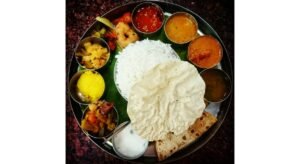Indian Veg & Nonveg Thali Prices Fall in September 2025
|
General Studies Paper III: Food Processing & Related Industries In India |
Why in News?
The prices of Indian vegetarian and non-vegetarian thalis became cheaper in September 2025, as per a recent Crisil report. This decline was mainly driven by a sharp reduction in essential commodity prices.
Thali Prices Dip in September 2025: Crisil Report
- In September 2025, the cost of home-cooked vegetarian and non-vegetarian thalis showed a noticeable decline compared to last year.
- According to a report by Crisil, the average price of a vegetarian thali decreased by 10%, while a non-vegetarian thali became 6% cheaper. This reflects easing prices of key commodities that form the base of these meals.
- A vegetarian thali in India cost 28.17 INR in September 2025, down from 31.30 INR in September 2024. On a monthly basis, the price fell 3% compared to August 2025, when it was 29.10 INR.
- For non-vegetarian thalis, the price in September 2025 stood at 56 INR, a decrease from 59.30 INR in the same month last year. Interestingly, on a monthly basis, the price increased by 3% compared to August 2025, when it was 54.60 INR.
- For many families, the vegetarian thali forms a daily staple for breakfast, lunch, or dinner. A 10% year-on-year reduction means households save almost 3 INR per thali, which adds up over the month.
- Crisil calculates the average cost of home-cooked thalis across North, South, East, and West India. The calculation is based on current food prices in each region.
- The thali cost includes grains, dal, vegetables, broilers (chicken), spices, edible oil, and cooking gas. Each of these ingredients contributes differently to the overall cost.
- The data represents home-prepared thali costs only. It does not include overhead expenses, staff wages, or profit margins charged by restaurants or catering services.
Composition of Vegetarian and Non-Vegetarian Thalis in India
A thali is a traditional Indian meal served on a single plate. It includes multiple dishes to provide a balanced diet. Thalis represent the typical home-cooked meals consumed across India and reflect regional flavors and preferences.
- Vegetarian Thali Composition:
- Roti (Indian Bread): A vegetarian thali usually contains roti or Indian flatbread. Roti is made from wheat flour. It provides carbohydrates and forms the base of the meal.
-
-
- Rice: Rice is another staple in a vegetarian thali. It is commonly served boiled or steamed. Rice provides energy and calories and complements curries and dal.
-
- Vegetables: A variety of vegetables are included in a vegetarian thali. Common vegetables are potatoes, tomatoes, onions, beans, spinach, and carrots. Vegetables provide vitamins, minerals, and fiber.
- Dal (Lentils): Dal or lentils are a protein source in a vegetarian thali. Dal is prepared from moong, masoor, chana, or toor dal. It is cooked with spices and sometimes tempered with oil or ghee.
- Yogurt: Curd is commonly added to a vegetarian thali. It aids digestion and provides calcium. Some households serve plain curd, while others prepare raita.
- Salad: A small portion of fresh salad is included for additional nutrition. Typical salad ingredients are cucumber, carrots, onions, and tomatoes.
- Sweet Dish (Optional): Some vegetarian thalis include a small sweet dish. It may be kheer, halwa, or peda.
- Non-Vegetarian Thali Composition:
- Roti & Rice: Similar to vegetarian thalis, roti and rice form the base of a non-vegetarian thali. These provide carbohydrates and calories needed to balance the protein from meat.
-
-
- Chicken/Meat Curry: The main protein source in a non-vegetarian thali is usually chicken, mutton, or fish. Chicken is the most common option in everyday meals. Non-vegetarian thalis derive almost 50% of their total cost from the meat portion.
- Vegetables: Non-vegetarian thalis also include vegetables. They complement the meat and add fiber, vitamins, and minerals. They are usually cooked as curry or stir-fry.
-
- Dal: Some non-vegetarian thalis include dal as a side dish. It provides additional protein. Dal is cooked in the same style as in vegetarian thalis. It balances the meal and enhances nutrition.
Reasons Behind the Drop in Veg & Non-Veg Thali Prices
- Potato Prices Drop: The price of potatoes fell by 31% in September 2025, which significantly lowered the cost of vegetarian thalis. The reduction happened because large stocks were released from cold storage units, increasing market supply. Potatoes form a major part of vegetarian meals, contributing to around 24% of the total veg thali cost along with tomatoes.
- Onion Prices Drop: Onion prices declined by 46% year-on-year, according to market reports. This fall is linked to a good Rabi crop and increased availability in local markets. Onions are a key ingredient in almost every Indian vegetarian dish, so their price reduction directly impacted the thali cost.
- Tomato Supply: Tomatoes became 8% cheaper in September 2025 due to better supply in the markets. Since potatoes and tomatoes together account for nearly a quarter of veg thali costs, the combined price drop reduced the overall expense significantly.
-
- Dal Prices: Dal prices also fell by 16% annually, which further reduced the cost of vegetarian thalis. Lentils are a staple protein source in India and are included in almost every thali. The combination of cheaper potatoes, onions, tomatoes, and dal made vegetarian meals more affordable in September 2025. However, some cost increases in vegetable oil (21%) and LPG cylinders (6%) slightly offset the total savings.
- Chicken Prices: The non-vegetarian thali saw a smaller price reduction because chicken prices, which make up 50% of non-veg thali costs, fell by only 1% due to reduced production and supply challenges in 2025. The price decline in vegetables and dal partially lowered the cost of non-veg thalis, but the impact was limited.
|
IMPORTANT FACT
|
|
Also Read: India’s CPI Retail Inflation Rises to 2.07% in August 2025 |










